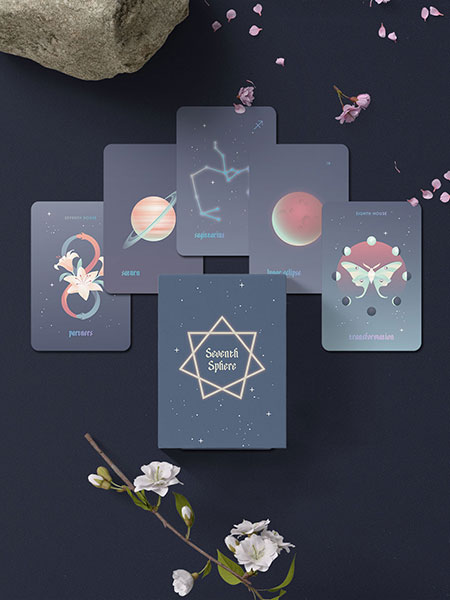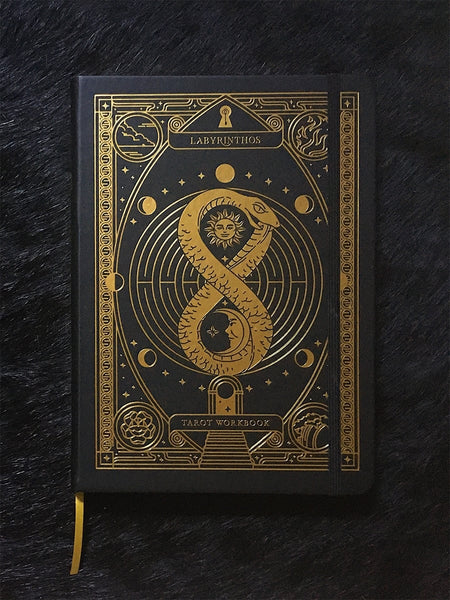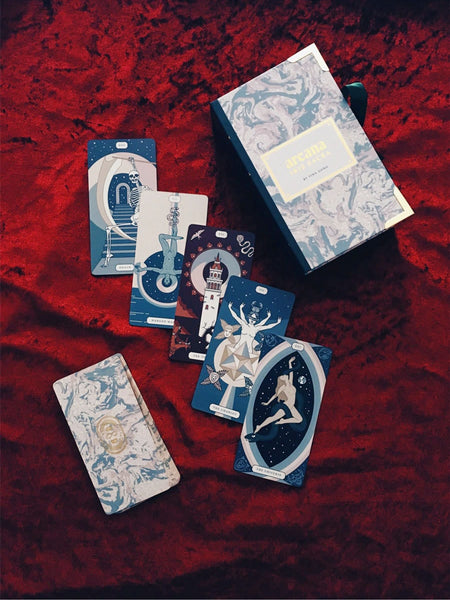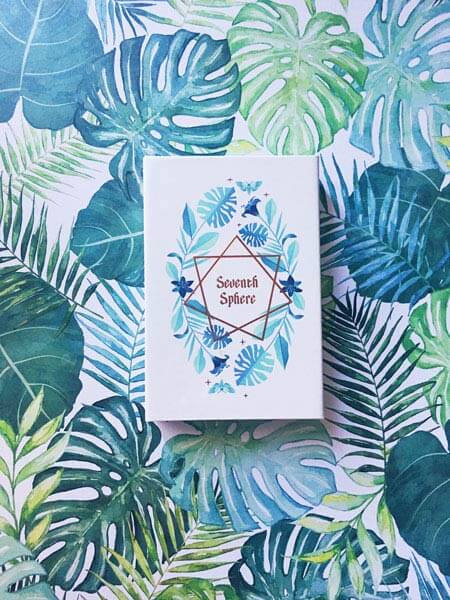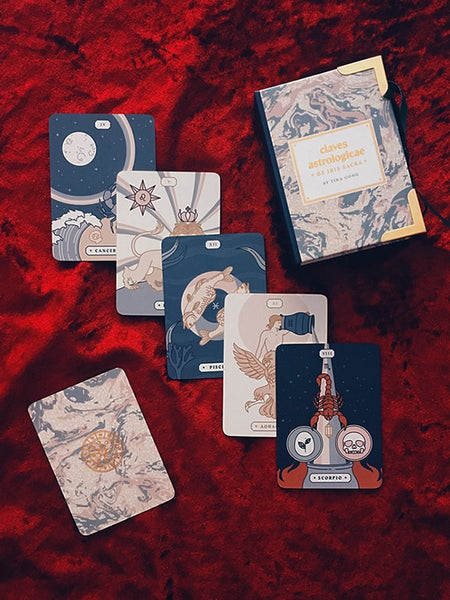✦ ✦ ✦
How to Create Your Own Tarot Spreads: A Step by Step Guide and Infographic
Published
Once in a while, while reading for both yourself and others, you’ll come across questions that can’t be fully answered using any of of the spreads that you’ve worked with before. You may find closer matches within the many reference books and sites that you find online (including ours!) - but this isn’t always a sure bet.
Sometimes, it pays off to design your own tarot spread — around your specific question and situation. It might be intimidating at first, but it’s also a great way to develop more confidence with readings, as well as create your own unique and creative approach to reading tarot cards. You’ll also slowly realize over time that the questions that you keep running into will be reflective of your own path, which sometimes gives your readings to others an additional personal connection. What we’re going to go through is my own personal way to designing tarot spreads and understanding of tarot in general, which relies on quite a bit of psychology and storytelling.
You’ll also slowly realize over time that the questions that you keep running into will be reflective of your own path, which sometimes gives your readings to others an additional personal connection.
Modifying Existing Tarot Spreads
If you’re nervous about constructing your own spreads, or it’s just something you’re not ready for yet - you can start by taking baby steps. Find a tarot spread that you’re comfortable working with - and add, or modify positions. One thing that you might naturally find yourself doing is using an additional card when looking for clarification about a particular position. Instead of just throwing a card on top of the spread, try asking a specific question about it first - articulate what extra information you’re searching for. This becomes the first step to get you started building larger spreads.

Understand the Question and Goal of your Tarot Spreads
There are two parts to a tarot reading that are important to think about; the question and the goal. The question is straightforward - but the goal may be more complex. It represents the longer term, indirect desire that you have regarding these questions. Sometimes, this goal will be implied and unspoken; a question about an argument in a relationship can ultimately be about what they need to find happiness and peace in romantic relationships.
Our deepest desires might be something that we are not able to articulate - and it is sometimes a tarot reading can help tease these out. While you don’t have to include these in your readings, I try at least to get a sense of these as I believe they give readings a more satisfying conclusion, and sometimes even be truly enlightening.
Our deepest desires might be something that we are not able to articulate - and it is sometimes a tarot reading can help tease these out.
If you’re doing the reading for yourself, you probably have a strong awareness of both of these. It’s a bit trickier if you’re reading with another person. You’ll have to work with them to more deeply understand the problem, and make sure they’re comfortable sharing that information with you. It helps to step into their shoes and empathize with what they’re experiencing.

What Do the Stars Bring You?
Get your personal free moon cycle tarot reading with our app, plus a black and white list of zodiac sign characteristics formatted for printers. Includes keywords, planetary rulers, symbols, elements and modalities.
Developing Positions for your Tarot Spreads
Here is where it gets a little complex - you’ll need to act more like an investigator when building your spreads. Your task will be to dissect the pieces of information you have into more specific questions, whose answers help you paint a clear picture of the situation. Broadly, I try to break down each question into three parts.
...Remember that what you’re doing is really telling a story — a story that you or your client plays a role in.
In general, remember that what you’re doing is really telling a story — a story that you or your client plays a role in. All stories have several parts that we need to make it compelling:
- The circumstances
- The underlying problem
- The solution
Asking a few questions from these parts can help develop the story and narrative from the tarot spread you are designing. The following section will give you some ideas about questions to ask, but don’t limit yourself to these examples. They’re meant to give you some quick inspiration to use, but there’s dozens of more questions you can be asking.

Clarifying the Circumstances
One big part of painting a picture for a tarot reading is developing the landscape and stage that everything plays out on. Context is a huge part of what shapes our lives - and sometimes, we need help understanding which pieces of it play a part in our question. Sometimes we even have trouble noticing these pieces. I’ve outlined a few examples of questions to ask regarding the context here:
- What do you have no control over?
- What is hidden?
- Who is involved?
- What do I need to know?
- How is your environment?
- Where can I find help?
- Where are opportunities?
- How am I approaching the problem?
- How do others perceive me?
- Where in the journey am I?
Targeting the Underlying Problem
While with some questions, the problems are obvious - but usually I’ve found throughout my own personal journey, that what is easy to articulate can be superficial - red herrings that keep you distracted from talking about the larger picture. Most of the time, the root cause of someone’s troubles are not an event, or an argument, or something external to themselves, but rather something that exists within - maybe a pattern, a coping mechanism, an inner trauma. An argument with a lover about who does the dishes can really be about feeling unable to communicate one’s needs. A few questions to try and tease these out are below.
- What is blocking me?
- What are the obstacles?
- What is my true wish?
- What is my ultimate goal?
- What would make me happy?
- What do I need to develop?
- What can I change?
- What are my strengths?
- What are my weaknesses?
- What is my biggest challenge?
Finding the Solution
Personally, tarot has never been a way to tell the future, but rather about being able to clarify and understand yourself well enough to take your future in your own hands. This part of the reading should focus on what you can do to take control of the problem. It’s all about developing a feeling of empowerment for yourself or who you’re reading for.
- What advice do I need?
- What can help me overcome?
- What can I do?
- Where is this leading to?
- How can I use opportunities?
- Where should I focus?
- What do I need to let go of?
- What do I need to learn?
Designing a Layout for your Tarot Spreads
Once you’ve pulled a few questions out for each section, you can now go ahead and think about the flow of the story - the order you want these answers to appear in, and generally how the story will look. Visually, you can lay out the cards in the shape of something that is related to the theme of the spread. A spread that asks about many decisions can be laid out like a cross, for example. The majority of the time, I like creating spreads that are symmetrical; personally I like creating a balance between positive and negative aspects of the question, and having that balance tends to give me a better reading.
One thing to note here though - the visual layout isn’t one that matters too much. If you’re doing this on the fly for someone else, even laying down the cards side by side shouldn’t be an issue. If you wanted to focus on something, it is more important to figure out the order in which you lay things down. Remember what we talked about earlier - it is the story you tell that matters, and usually stories are told by laying out the circumstances, developing the problem, and creating a resolution.

Take Your Tarot Spread for a Test Drive
Finally, to make sure it all flows to together, we get to the fun part! (Or the tedious part, if you’ve been working on the spread for a long time.) I’m a user experience designer by trade, so a huge part of that is doing user testing - which is just silly jargon for testing something you’ve designed on a real population to understand where it is working, and where it isn’t, and how you can improve it. With each new reading that you give with your spread, you’ll get more information, and more ideas about how to tweak it until you’ve got something you’re satisfied with.
So that’s it! I hope this has been helpful in you all creating your own spreads. If you have any questions at all, or even if you’ve got tarot spreads that you’ve created with this method, feel free to share it with us here in the comments below.

2 comments
-
scarlet brooksgoing to have a go at this later
-
EricExcellent!




